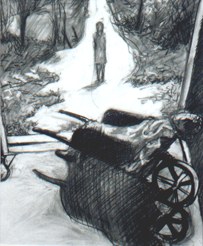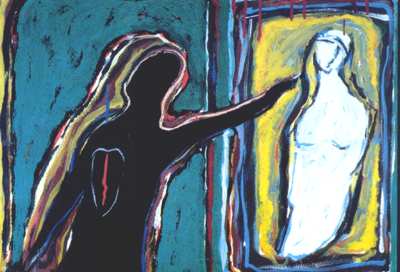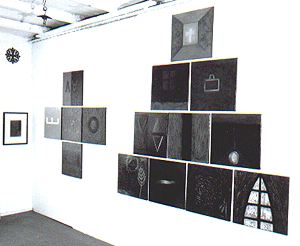BAFA © 2010. All material here is copyrighted. See conditions above. |
Hervé Constant
painter, U.K.
|
The Creation of Symbols
Interview between the visual artist, Hervé
Constant,
and the psychotherapist Madelyn Freeman, November '98, London.
|
...Very often
symbols are derived in response to a theme that I am working on or they
can appear as a reflection of specific past events that relate to an emotion.
Symbolic representations can also result from studying the things that surround
us. Symbols work on different levels, such as representing objects we relate
to directly, or as things that are hidden from us. Symbols can unsettle
or confirm in us certain social values. Symbols have been with us for a
very long time and their application is a natural one. Everywhere you go
- to the shops, cinema, on highways or simply in the street - symbols surround
us. They can lead or direct us, make us purchase goods, fight each other,
make love to each other.
As an artist, I can choose which symbols I want to use in order to direct
my mind and make certain thoughts explicit...
|
 |

|
MF:
Are you suggesting that you are driven by a compulsion from within to complete,
create and make room for an image to reach visual expression?
HC: It is true that one can be driven since many of the symbols used are
derived from the unconscious, but my feeling is that often one makes a definitive
and personal choice as regards which symbols are painted. Certainly one
chooses the colour that re-informs or reconstructs an expression. The 'Magician'
card in the Tarot, for example, exemplifies for me what is still exciting
about engaging in the creative process. I am now in my late 40's and the
unknown is why I still feel a child-like excitement about the work, since
there is a certain alchemy about it. It is because there is something that
still surprises me, something that I don't know....
|
MF:
In terms of the alchemical process, could you describe this process as the
'nigredo'- emerging into darkness - in order to bring something from that
darkness into physical reality? As you know, it has been suggested that
the alchemical process runs through a distinct series of phases, which can
be represented as colours.
HC: There are many different levels involved in achieving this. Sometimes
one starts only with colour in order to balance tones, adding black or white,
to give weight to a picture. Certain colours
become like a symphony of tones, each with their own different strengths
and values, such as passion, despair, coolness or quiet dreaminess or absence.
On the whole colours have their own language - whether they express spiritual
or reposing values, confidence or anguish - which is why I wanted to change
some previous works. As one grows older, one perceives the same things differently,
so that the meaning of colours will vary...
|
 Soul,
1995,
Soul,
1995,
oil on canvas,
by Hervé Constant
|

Reaching, 1988, acrylic and pastel on paper, 30 x 40 inches.
|
The language very often portrays my profound solitude and the difficulty that I have in understanding many of the things surrounding us, since I find so many things, particularly those imparted to us by the state, to be absurd. My art fulfils, for me, its real function, which means that I can find a certain peace and fullness in my life. It becomes a dialogue and study of oneself. Symbols are often the result of obsessional worries but their revelation I think. This balances the psyche and gives the soul a responsive inner life, which gives purpose and a richness of meaning.
|
...That is the reason why so many of the things I paint are symbolic. Take, for example, the suitcase. It has been nowhere and everywhere accompanying someone of passage. Nowhere is its home yet everywhere is its home...
MF: Being nowhere and everywhere - is this a principle that applies to a major portion of your work? Can you elaborate on what you mean by travelling nowhere and everywhere?
...When I first came to London I felt that I no longer needed to have a nationality or race anymore but that I needed to discover myself, which also meant I could be different. If I had remained in France perhaps I would have had a stronger feeling that I was, more or less, French, North African or whatever....
Excerpts from pages 10 - 12, Arts Dialogue, October 2001.
|

Tetraktys, 1997, 10 pieces, 50 x 50 x 10,
encaustic on canvas.
|
- Article and images: The Creation of Symbols, Arts Dialogue,
October 2000
- Illustration: Labyrinth on a French castle door, Arts Dialogue,
June 1999
- Artist Profile: Arts Dialogue, December 1997
- Illustration: Union of Opposites, Arts Dialogue,
September 1997
|

Arts Dialogue, Dintel 20, NL 7333 MC, Apeldoorn, The Netherlands
email: bafa@bahai-library.com
|
|


 Soul,
1995,
Soul,
1995, 
